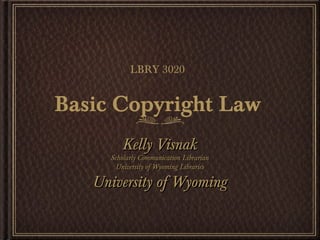
Understanding Copyright and Author Rights
- 1. LBRY 3020 Basic Copyright Law Kelly Visnak Scholarly Communication Librarian University of Wyoming Libraries University of Wyoming
- 2. Publication (Registration Creation and Certification) Dissemination Manuscript & IP Editor Academic Publisher Library Peer Reviewers Reformulation
- 4. internet editor Peer-reviewers creation publication dissemination reformulation Publishers Libraries Disaggregation of traditional system is in process…
- 5. Fashion World an open culture of creative innovation = profit http://www.ted.com/talks/johanna_blakley_lessons_from_fashion_s_fr ee_culture.html Johanna blakely on TED.com www.ReadyToShare.org
- 6. What is copyright? Copyright is a bundle of rights: The right to reproduce the work The right to distribute the work The right to prepare derivative works The right to perform the work The right to display the work The right to license any of the above to third parties
- 7. Who is an author? 3 scholars who do joint research and each write a section of an article. A book author and her editor. A photographer and the person whose picture he takes. A university librarian who writes a report for a library association and is paid $1500. The PI whose name is listed on a published article but who wrote no part of it.
- 8. Who is the copyright holder? The creator is usually the initial copyright holder. If two or more people jointly create a work, they are joint copyright holders, with equal rights. With some exceptions, work created as a part of a person's employment is a "work made for hire" and the copyright belongs to the employer.
- 9. How? • You used to need a little c in a circle © and to register your work with the copyright office. • Not anymore. • Copyright exists from the moment of creation, and lasts for the life of the author plus 70 years. • Copyright just happens.
- 10. Requirements for protection An original work of authorship Creativity (just a dash) Fixed in a tangible medium of expression
- 11. What copyright protects Copyright doesn’t protect… Copyright protects Ideas Writing Jokes Choreography Facts Recipes Music Titles Visual art Data Film Useful articles (that’s patent) Architectural works
- 12. As run the sands of time, The bundle of copyrights lasts a long time: Life of the author plus 70 years For joint works, 70 years after death of last author For works for hire or anonymous works, 95 years from publication or 120 years from creation, whichever expires first.
- 13. Quick review… Protection is automatic once a work is fixed Very little creative originality is necessary Registration is not necessary Joint authors each have equal, full copyright
- 14. Fair Use Fair Use is a statutory exception that allows the use of a copyrighted work for certain purposes without requiring permission. (See 17 USC § 107 ). 5 • There is no easy formula for determining fair use, but there are four factors to consider: 1) The nature of the work (factual, creative) 2) The purpose of the use (educational, for-profit) 3) Amount of the work being used 4) The potential impact of the use on the market for the original.
- 15. TOOLS • Know what you can do http://www.knowyourcopyrights.org/bm~doc/ky crmatrixcolor.pdf call: 1-650-372-9934 Fair Use Visualizer http://www.benedict.com/Info/FairUse/Visualizer/Visuali zer.aspx Digital Copyright Slide Ruler http://www.librarycopyright.net/digitalslider/
- 16. Using Copyrighted Works It is against the law to reproduce copyrighted materials, in full or in part, without previous permission of the copyright owner. If you need to include copyrighted source materials in your document, you must obtain written permission from the copyright owner prior to its use. •Note: Copyrighted materials include: tables, charts, graphs, maps, questionnaires, illustrations, photographs, literary works, etc. Best Practice: • Add an appendix to your document • Showing the written permission you’ve secured from the author or publisher
- 17. Author Rights in Publishing
- 18. Giving away copyright? No need! Licensing allows specific rights to be retained: • Authors keep copyright and license other rights (e.g., first publication) • Publisherstake copyright and license rights back (e.g., reproduction, derivatives) Copyright can be transferred only in writing Addenda can be added to publication agreements to open the door for negotiating rights retention
- 19. Bundled vs. Unbundled Rights publishers traditionally want: • Reproduction, distribution, derivatives…ALL!! Rights publishers actually need: • Right of first publication…that’s it, really Specific rights can be bundled or unbundled by licenses (e.g., Creative Commons) or addenda (e.g., SPARC) or negotiation Open Access publishers usually do not require full transfer of copyright
- 20. “If…then” – the secrets of reuse By the author • If full rights retained, then limitless (within confines of law, that is) • Ifsome rights retained, then within limits of negotiated rights • If no rights retained, then fair use only By others • If published open access, then freely accessible – and possibly more • If published under a Creative Commons license, then within limits defined by the license • If published traditionally, then fair use only
- 21. It is your Right to Modify the Publishing Agreement • Distribution on campus • Distribution off campus • Archiving on website • Archiving in repository • Derivative creation • Performance • Display • Save a copy of your agreement.
- 22. Take home points We all own copyright until we sign it away Contracts are negotiable, including publishing contracts Think ahead to how you might want to use your work Experimentation via CC licenses, attaching addenda or negotiating isn’t scary and doesn’t negate peer-review prestige
- 23. • • This work was created by Kelly Visnak for University of Wyoming Libraries, February 2013 with use of slides and support information created by Lee Van Orsdel, Molly Keener and Sarah L Shreeves for the ACRL National Conference, Scholarly Communications 101 Workshop and then updated by Molly Kleinman and Kevin Smith in March of 2010. • This work is licensed under a Creative Commons Attribution Non-Commercial Share Alike 3.0 United States license: http://creativecommons.org/licenses/by-nc-sa/3.0/.
- 24. Questions... Kelly Visnak Scholarly Communication Librarian kvisnak@uwyo.edu